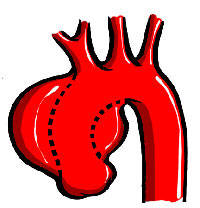|

Autoimmune Aortic Aneurysm
|
Aortic aneurysm
is a rare but life-threatening cardiovascular complication
in patients with autoimmune disorders. The purpose of this
study was to clarify the characteristic clinical features
and the pathological mechanism of aneurysmal formation in
those patients treated with corticosteroids. Methods. Among
429 patients operated on for abdominal aortic aneurysm
during the past 10 years, six patients with autoimmune
diseases treated with corticosteroids (one with progressive
systemic sclerosis, one with rheumatoid arthritis and four
with systemic lupus erythematosus) were reviewed
retrospectively. Their data were compared with those of 391
patients with atherosclerotic aneurysms with no autoimmune
disorders. The resected aneurysmal walls of the six patients
were also compared histopathologically with those of the
last six consecutive patients in the control group. Results.
The average age of the patients with autoimmune disease was
younger than that of the control group (53.8±16.6 vs
71.8±7.8 years; p<0.05). Patients with autoimmune disease
had received long-term corticosteroid therapy for 15-32
years; mean 22.2±6.5 years. Pathological examination showed
that the destructive change of the medial elastic lamina in
the autoimmune disease group was wider than that in the
controls. Most patients had no complications in the
postoperative follow-up period (5.1±3.2 years), while one
patient died of rupture of a dissecting aneurysm two years
after operation. Conclusions. Prolonged corticosteroid
treatment probably plays a major role in the disintegration
of connective tissue of the media, possibly together with
primary aortic wall involvement andlor vasculitic damage in
patients with autoimmune disorders, which can result in
aortic aneurysmal enlargement.
Of the 31 patients with IAA, 6 patients (19%) had autoimmune
disease, compared with none of the control subjects (P
=.0017). Two patients had rheumatoid arthritis, 2 patients
had systemic lupus erythematosus, 1 had giant cell arteritis,
and 1 patient had an undifferentiated seronegative
polyarthritis diagnosed as rheumatoid arthritis. Nineteen
patients (61%) with IAA had involvement of the duodenum, and
8 patients (26%) had hydronephrosis with ureteral
involvement.
Annual incidence
Most of the aneurysms in humans are autoimmune and
triggered secondary to a infection or chemical exposure.
|